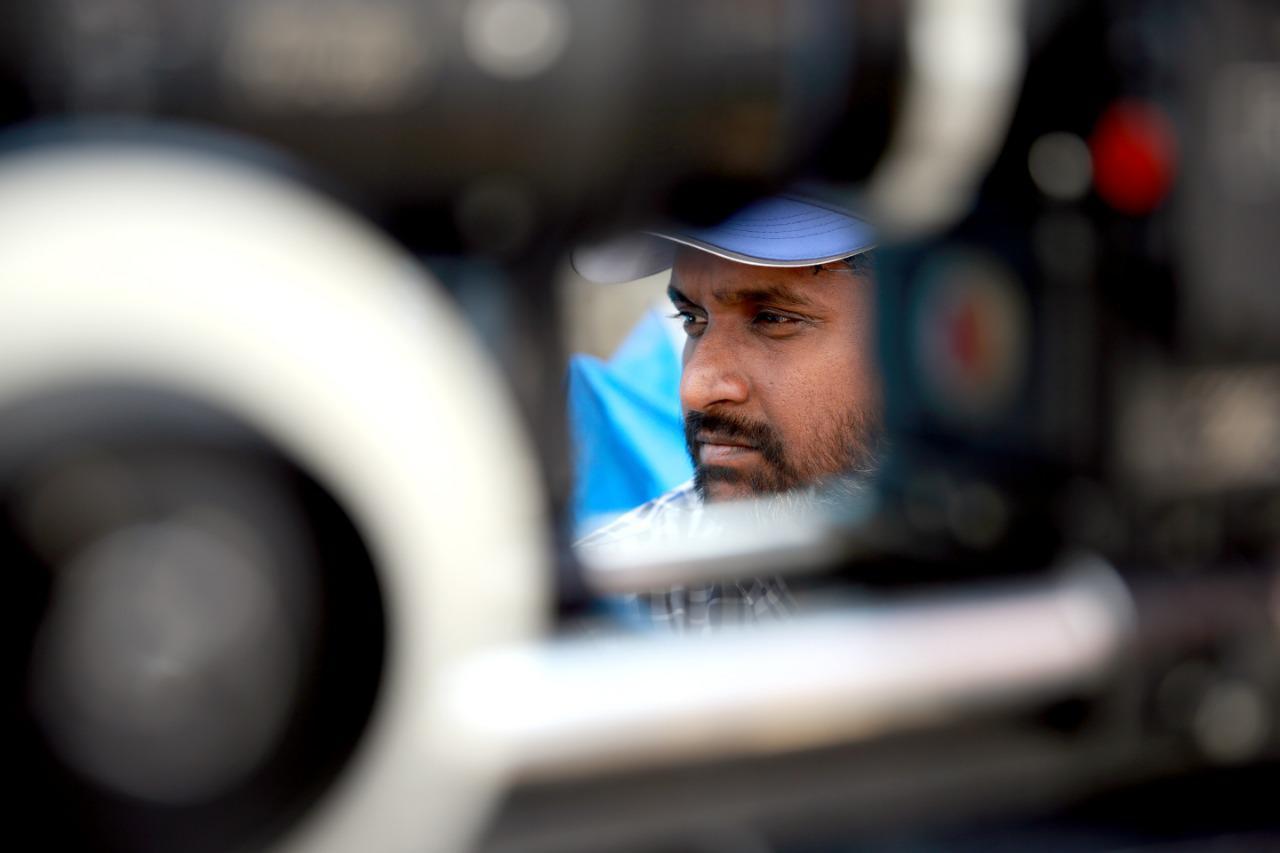
In Conversation : Manoj Paramahamsa
May 20 2020
Manoj Paramahamsa most popular cinematographer who has achieved unique style of visuals from his first film…and the variety of looks he creates for each project is different.
Manoj shares his visual journey with SICA.
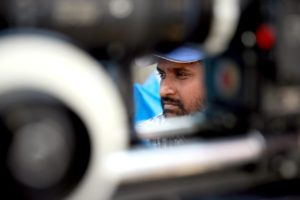
1)To start with your acclaimed and debut film ‘Eeram’, we got to know that you designed the film’s look, by having the rains in mind. Do share us something about the making of the film.
Yes.The script demanded such treatment and the director wanted us to feel the wet & moist throughout the film. It was a challenging task to create that look in Chennai where the period of rain is very limited. Also, based on the script we fixed ‘grey’ as the colour palette for the film and we want to maintain the colour throughout the film predominantly. And, since it is a supernatural film, whenever there is a murder happening we gave a ‘colour instinct’ – ‘red’ which mixes with the water give the feel of blood. Director Arivazhagan demanded such treatment for the film and I have also added a tinge of ‘cyan’ through DI, which is the opposite colour of Red. For example, when the guy gets the goldfish and putting it in an aquarium & when the small girl tries to get the water from the water dispenser, the whole scene has rain outside surrounded by grey and has a strong element of red in it. we have made the entire film look like -’minus red’ and the essence of ‘red’ will be only seen during the murders.
2)And, for the outdoor shots particularly, how have you created the rainy day look?
Throughout the film rain plays an important role, we want to have real grey clouds and overcast sky. So, whether the day is rainy or sunny,we shot most of the scenes with wide shots at 5.30-6.30 in the morning which has the sky with natural gray shades. So, we ended up having mostly sunrise call sheets, and the production really supported & understood that we want to create this specific look. Also, to mimic the overcast sky I have used a ‘heavy frost’ filter in front of the lights and during those days there was a practice of using filters for individual lights separately. But I want to create the effect of a single overcast sky and placed a huge sheet of filter (like 12x 12) combining 3-4 lights together, to create a one single large overcast light like sky. I used Heavy frost for its soft diffused light with its soft edges. This helped me to look like the light emanating from the sky. Also, I have exposed for the sky, which made the foreground a bit deeper. So, we drenched the floor with water so that it will look like as if it rained the prior day and the reflections in the water created a nice contrast
3)Interesting. How did you shoot the interiors and the Apartments ?? Even those were Grey.
Yes, I and Director Arivazhagan were specific with the colour grey and we have looked for around 200 flats around Chennai, Cochin & Hyderabad and we couldn’t find a perfect one. But fortunately, we have got one apartment at the back of the very famous Doshi gardens, with the grey colour we want. Unfortunately, the flatmates were hesitant to shoot inside the premises and they were about to change the colour of flats. And thanks to our producer Director Shankar who intervened and convinced them to shoot. We also have assured that all the junior artistes should wear grey tones avoiding the other colours and even bought specific costumes for them suiting the colour palette of the film.
We also concentrated very much in production design and we have constructed three sets with real flooring using marble, tiles and granites. We carefully avoided all the colourful properties, even the gas cylinders. Though we could have achieved the tone through colour correction, we have created the colour tone through careful production design, so that we can preserve the skin tone in DI.
4)And could you tell us a few about the CG shots of water, which were so realistic?
My main intention was, I want to get the reflections properly though we are creating the water through CG. Usually, if there is a CG element in a film, there are chances we tend to find the essence of CG easily and I really don’t want that to happen. So, after doing small research, I found proper HDRI image mapping has to be done to get the proper reflections in the water. That’s when I came to know about ‘Chromeball’ which was very new to the CG world at that time and we need to create the high dynamic range mapping of the background to create realistic reflections in water created by CG. With the help of ‘chromeball’, we have taken the background details in 360 degrees with high resolution still cameras, with 5 stops overexposed & 5 stops underexposed. All the images were stitched in Photoshop to get the high dynamic range image and this final mapping image was given to the CG team to create the water in 3D with natural reflections.
5)What are the complex shots you shot in the movie? and some CG shots of water running, you have to do the repetitive camera movements for different CG reference plates. When motion control cinematography was obsolete at that time? How did you achieve that?
I have got around 13 shots which were a bit complex as it was having CG elements of water and complex movements. Thus we have planned to go for a ‘previz’ and it was in the early stages of ‘previz’ & very few have tried it. Since I have had the VFX education before my Film institute studies, I had the knowledge of these things and recreated the whole set in 3dsMax. Thus we were able to figure out the mistakes in the movements and did the changes.
And for water movements, we need to take different shots for CG plates and when we take the different plates for the CG shots, we need to repeat the same camera movement with the same rhythm, recreating the timing every time. At that time there was no motion control equipment, but we have done it manually with the help of ‘Nagra’.
We laid the tracks for the movements and made the nagra to run first. Also, we pasted a white marking tape along the track and when we started moving the trolley, we counted the numbers 1,2,3…. and we marked the same in the white tape and the sound is recorded in the nagra. And, again for the next plate, to repeat the same pace of trolley movement, we playback the nagara and moved the trolley marking the numbers again in new white tape, based on the recorded sound. Thus If the trolley is not in sync with the previous shot, there will be a mismatch in the makings and we repeat the trolley movement until the pace is perfectly in sync with the previous one. That’s how we created the same camera movements for the next consecutive plates and for us, ‘Nagara’ helped as a ‘motion Control Equipment’. We really should thank renowned VFX supervisor Mr Srinivas Mohan & his team, who were very helpful in executing this process.
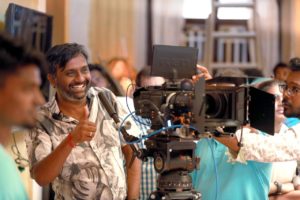
6)It’s such an amazing thing to hear. Tell us your experience of working with Director Gautham Menon. And Of course, ‘Vinnaithaandi Varuvaaya’ is a breakthrough film of yours. Tell us something about the working experiences in the film.
I have got the opportunity through one my friend who was with Gautham Menon and he was looking for a young Cinematographer with good First we started to work on ‘Chennaiyil Oru Mazhaikkalam’ which unfortunately didn’t take off. Immediately we got to work for ‘Vinnaithaandi Varuvaaya’. It was really a challenging film because, while narrating the script itself, he wanted to have more whites in the film, which was a big challenge for me to control the whites. We particularly scouted a lot to get the Church, homes everything in white. It was a challenge to shoot and I did a lot of directional lights to create a lot of patterns & shadows to avoid the whites getting bleached out. One other interesting portion was, I shot the title portions with 300 feet akela crane mounted on three boats and it was the era we don’t have drones. It was a challenging shot to move the crane moving across the water body and it reaches the height of the church when the title card ends. In such a way ‘Vinnaithaandi Varuvaaya’ was interesting and challenging as well to shoot and the film’s work got me multiple offers in Tamil & Telugu. Till now we have an excellent rapport and have been working for multiple projects like Nadunisi naaygal, Enai Nokki Payum Thotta, and Dhruva Nakshatram.
7)Could you share with us the experience of working with Director Shankar for ‘Nanban’? We got to know that Shankar was very particular of having you to shoot for ‘Nanban’?
Director Shankar Sir was the producer for my first film ‘Eeram’ and during those days he was a bit reluctant towards my choice of colour palette, and we know he is known for using vibrant colours in his films. Interestingly, Shankar sir seemed very much liked about the visuals of ‘Vinnaithaandi Varuvaaya’ and he called me to shoot for Nanban. It was immediately before the release of Endhiran, but I couldn’t accept the offer initially because I was committed with Gautham Menon sir for his next two films.Thankfully 3months after the release of Endhiran,again I got the offer from Shankar and I was totally in awe. Unfortunately during that time, the two films of Gautam Menon got delayed, I immediately accepted the offer from Director Shankar.
8)Though ‘Nanban’ was a remake of ‘3- Idiots’, the visual of Nanban seemed different from its Original. Could you share something about that?
Yes, it was. The director of the film Rajkumar Hirani is a renowned editor who worked for many films of Vidhu Vinod Chopra. 3- Idiots has very few camera movements and & he is a master of block shots who tells the story through editing. I think the editor in him seemed to like him to go with more static shots and moreover Amir Khan’s screen presence & performances are the highlights of 3-Idiots.
Whereas, for ‘Nanban’ Being a Shankar sir’s film we thought of adding more vibrancy and mobility. I have used different camera movements in Nanban in contrast to 3-idiots and the main challenge was to make Vijay, Srikanth & jiva, to look younger by 20 years. So, I fixed to go with very soft lighting using a double frost filter, with almost shadowless lighting.
9)Could you share with us, about the shooting locations of ‘Nanban’, which played an important role in the film’s visual?
Yes, we have taken many efforts in choosing the locations and for the location scout itself, we took about 180 days. The most challenging part of the scout was for the college building. Shankar sir didn’t like.the usual pattern of black and brown & he wanted to have a unique colour(like beige) which was less seen. At Last, we found a college in Dehradun and for about 6 trucks of materials were taken on the road.
Though we have shot the mail building in Dehradun, we also shot some 13 other elements separately in different locations. One interesting setup was the classroom, which is a unique gallery type of classroom in Stanley medical College, Chennai and we have got only one Sunday permission to shoot. So we have used more than 1500 tube lights fixed over the roof and diffusion filters were used to soft light throughout.
10)How did you correct the Lights?Have you used the Minus Green filter to remove the greens of fluorescent tubes?
No, I didn’t use it. Because there is no point in having the filter for such a big area, which consumes more number of filters and it cuts off the light too. And, I always go with the easiest process to achieve the desired effect. The experience I had in ‘Eeram’ helped me what I can achieve through DI and I have corrected the skin tone in DI. For the day ambience, I have used lights with more CTO filters. Thus the warm naturally cuts off the green inside and it got neutralized.
11)And how shot the final portions of the film? The portions were stunning like 3-Idiots.
In 3-idiots they have shot in Ladakh and we felt it will not be suitable again in Nanban. Though initially, we zeroed in Dhanushkodi to shoot the sequence, the place looked so dry and we couldn’t feel the aqua blue which we saw in 3-idiots. There I got an idea to shoot the aerial shot of water across the Pamban bridge(Rameswaram), which has the aqua blue we want. Since I have already shot a video song ‘Semmozhi’ song in Pamban bridge in a chopper with earlier D21 cameras, I have shown the shot footage to Shankar sir. He was very impressed with the look and I gave the idea that we can include the car in CG. To shoot the other portions in the land, K. V. Anand suggested an island in Andaman & Nicobar, where he shot a song sequence in Chellame which has the aqua blue we want.so we can match the same aqua blue with the aerial shot. Unfortunately, when we arrived there, we didn’t get the feel we wanted as it was highly destroyed by the recent then Tsunami. Then after a couple of days, we found the island called Cinque Island which has the look we want.
And for the final shot of the film, I suggested Shankar sir that it would be nice if we have an Akela crane to shoot the aerial shot of two lands joining in water. He immediately liked the idea and we shifted the akela crane & Volvo car in ship two months before the shoot to port Blair. From there, through small boats, we shipped the crane and car to the shooting island.
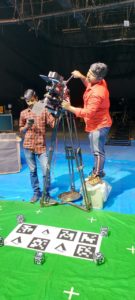
12)Tell us about Telegu projects particularly Race Gurram & Kick 2 which helped you arrive in a leading position in Telugu Cinema.
I have got a few projects in Telugu earlier after Eeram, but it didn’t materialize. But, after my works in ‘Nanban’, ‘Vinnaithaandi Varuvaaya’ (Telugu- Ye Maaya Chesave), I have got the offers and Race Gurram was my next film in Telugu. ‘Race Gurram’ was a trendsetting film at that time and we have erected multiple sets for the film. The film has many sets erected for individual scenes which were very rare to see during that period. I have used panther dolly for many of the shots and used 18KW light extensively for the whole film. Both the dolly and light was not available at that time and I have convinced the producers to get the same. The film was much appreciated and praised for its visual treatment and Allu Arjun specifically appreciated me during the success meet of the film, saying this film cinematography has taken the next level in Telegu cinema.
Coming to Kick-2, again the film is from the same director. The film was much-praised for the sequences in the desert, which was taken a long way from Jaisalmer, 50 Km near to Pakistan. It was tough to shoot there because of its adverse weather conditions and to shoot the sand without dunes. It was also much appreciated for the railway station which was a set constructed and the train coming amidst the desert created much visual drama.
13)We are in the age of Digital and the monitors play an important role and you seem to be a big fan of professional monitors like Flanders FSI. And are you trying on-set grading?
I started using on-field monitors since ‘Eeram’ times. Since the film ‘Eeram’ has many low angle shots in panther dolly, naturally it avoided the purpose of optical viewfinders and we have to rely on Digital monitors. From then I like to work with monitors and I want to break that we have to use only viewfinders. And I feel it’s not comfortable to see the colour visually at that close to our eye. So I have gone for professional colour corrected monitors which also have perfect black levels. I have used a DM 250 monitor FSI monitor at that time and it has the option of applying customized LUTS over the on-screen footage. Also, there is an option called ‘luminare’ in FSI monitor where I can lock my ranges of shadows and highlights. It’s more of like the false colours and for example, I have fixed my shadows in level ‘6’ and highlights in ‘93’. So, it’s more of like ‘bracketing’ and we can be assured if my scene elements don’t exceed these limits. I should really thank Mr Glen, a colourist from Poland introduced these things with whom I worked for a Kannada film called ‘Jaguar’.
Coming to on-set grading, I started a bit, but Mr Glen gave me an insight why we should create something in DI & he urged me to do whatever the effect we want, we have to create it on set lighting. He also added that the colourist’s role was to fix only the colour timing and fixing the tone in DI is not appreciable and it will do adverse changes in blacks & whites. From then I have been following this and whatever the tone I want to have, I try to emulate from the lighting itself and lessen the timings I spend on Colour grading. I am using this software called ‘stellar’ and with FSI monitors I control and fix the tone of the film on location through lighting itself. Even for my recent web series, Auto Shankar I didn’t work much on colour grading and simply applied a film stock LUT throughout and have taken the output.
So, my final thought is, whatever the look or tone you want to have, create it on set so that you can preserve the whites & blacks with the fullest control on your colours.
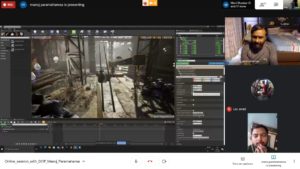
14)You seemed to be a ‘Tech Geek’, trying newest things in the industry and we heard you have your own set of inventory ??. Share us something.
Thanks for the compliment. Since my film institute days, I am always keen on new and emerging technologies. Starting from using a Pather dolly, FSI monitors even I use special rigs for Gimbal. For a year I served as a brand ambassador for RED cameras after the release of their powerful sensors RED Helium & RED Monstro.
15)Could you share with us about the ‘Virtual production’ tool which you are working on now?
Currently, I am shooting a film of actor Parbhas film which has some very interesting CG elements and we have a 12-minute portion that involves a complex CG. For that particular scene, for the past two years, we have been working on a previz done by a US company. During this period while doing the R & D for the betterment, I came across the Virtual Production tool called ‘Unreal Engine’.
‘Unreal Engine’ is a company primarily works for the gaming industry known for its for the creation of the realistic 3D world, which renders in real-time. The realistic portrayal had gained huge momentum and they started adapting and applying the same for filmmaking. From 2016 they have got 4 versions and the whole VFX world is waiting for its latest version Unreal Engine 5 which is releasing shortly.
The newly developed system helps to visualize 3d world on-set. They use unique tracking devices to capture the camera movements in the real-world and the X, Y, Z coordinates & Pan-tilt datas will be fed into the unreal engine to the 3D space. The 5 datas we transferred will be applied to the virtual camera in the 3D world. Then the output from the virtual camera will be rendered with the real foreground footage using a rendering software that composites the virtual world with the real world in real-time. With two monitors one with the green screen footage and the other with the 3d composited image we will be able to see the Live rendering output and it reduces a whole lot of time needed in older composting techniques. The most important thing is, we need to the same lighting to the real world and to the virtual world.
And for the recent Disney’s film ‘The Mandalorian’, the film’s complete VFX was made by the unreal Engine by this ‘virtual Production technique’ avoiding the using regular composting techniques. For nearly 40% of the film, they projected the virtual world on the LED screen with the actors in the foreground and they did the in-camera VFX. For the remaining 60%, they shot with regular green screen technique, compositing with a virtual world.
With this unreal engine, we can create a world from the real world with the reference of our real world and even it has numerous libraries, by which we create our own imaginative virtual world. Using the same technique, using Unreal Engine I have shot a scene for the prabhas film. We created a virtual lake from the references of a real lake in New Zealand and it really came out really well. Also, for the next web series, with the story happening in the 13th century, I am going to use this Unreal Engine extensively.
16 Tell us something about ‘Poovarasam Peepee’ being a Cinematographer & as a Producer.
I have always wanted to be an independent filmmaker and ‘Poovarasam Peepee’ was my first film as a producer. I was not only serving as the cinematographer, but I also did the work of DIT and even colour corrected my own footage. I have bought RED Scarlet exclusively for the film and used Davinci Resolve for colour grading. I think ‘Poovarasam peepee’ was the first film to use the still camera lenses. We used Zeiss photography lenses for the whole film.
Drafted by : Gowrishankar ( Cinematography faculty)
Conversation idea by : Mahesh Muthuswami and C.J.Rajkumar
